The automotive market is witnessing a surge in compact SUVs, with Volkswagen stepping up to the plate with its two promising contenders: the T-Roc and the Taigo. Both models embody the spirit of versatility, style, and performance, but they cater to slightly different preferences. This article delves into a detailed comparison of these two vehicles, focusing on their technical specifications, performance metrics, and innovative features.
VW T-Roc vs VW Taigo – Which one offers the better deal?
Two cars, one duel: VW T-Roc meets VW Taigo.
Which one wins in performance, efficiency and value for money? Find out now!
Design and Dimensions
The VW T-Roc is known for its sporty and robust appearance, characterized by bold lines and a muscular stance. It measures 4,236 mm in length, 1,819 mm in width, and stands at 1,584 mm high, making it a compact yet spacious SUV. In contrast, the Taigo is slightly longer at 4,266 mm and measures 1,757 mm in width and 1,518 mm in height. While both models feature the traditional SUV silhouette, the T-Roc leans toward a more rugged aesthetic, while the Taigo offers a sleeker, coupe-like profile.
Powertrain Options
Under the hood, the T-Roc boasts a diverse range of powertrains, including petrol and diesel engines, offering power outputs from 115 HP to a robust 300 HP for the sporty R version. With options of both front-wheel and all-wheel drive, it caters to a variety of driving needs. The engine options include 1.0L, 1.5L, and 2.0L configurations, ensuring there’s a blend of efficiency and performance.
On the other hand, the Taigo is exclusively powered by petrol engines, with a range that tops out at 150 HP. It offers a simpler engine lineup, with choices of either a 1.0L or a 1.5L engine, which should appeal to urban drivers prioritizing fuel efficiency over outright power.
Performance and Efficiency
When it comes to performance metrics, the T-Roc showcases impressive acceleration figures, particularly in the 2.0L variant, which can reach 0-100 km/h in just 4.9 seconds. The T-Roc also stands out with its maximum speed that can reach up to 250 km/h, depending on the engine variant. Fuel consumption varies, with some models achieving as low as 4.7 L/100 km, presenting an excellent balance for performance enthusiasts and eco-conscious drivers alike.
The Taigo, while not as fast, still delivers respectable performance. The swiftest version accelerates from 0-100 km/h in 8.2 seconds, with a top speed of 212 km/h. Its fuel efficiency shines through with figures as low as 5.4 L/100 km, making it a terrific option for those who navigate urban landscapes frequently.
Interior and Technology Innovations
Inside, both vehicles offer a modern and practical cockpit. The T-Roc, with a trunk capacity of up to 445 liters, provides ample storage for weekend getaways or grocery runs. It features high-quality materials and a customizable digital cockpit that enhances the driving experience. The T-Roc is available with state-of-the-art infotainment systems and driver assistance technologies, including adaptive cruise control and lane-keeping assist.
The Taigo, with a slightly smaller trunk capacity at 440 liters, still offers sufficient space for everyday use. It incorporates many of VW's latest tech features, including a digital cockpit, which offers a clean and user-friendly interface. The Taigo includes notable safety features such as blind-spot monitoring and collision prevention systems, catering to safety-conscious buyers.
Conclusion: Choosing Between T-Roc and Taigo
In summary, both the VW T-Roc and Taigo exhibit Volkswagen's commitment to creating efficient and stylish SUVs that meet various consumer needs. The T-Roc excels in performance and versatility, making it perfect for adventurous drivers, while the Taigo stands out for its sleek design and practicality for urban environments.
Ultimately, your choice will depend on personal preferences—whether you prioritize high performance and all-terrain capability with the T-Roc or prefer the Taigo's efficient and stylish approach to city driving. No matter which you choose, both vehicles promise a rewarding driving experience.
Here’s where it gets real: The technical differences in detail
Costs and Efficiency:
Price and efficiency are often the first things buyers look at. Here it becomes clear which model has the long-term edge – whether at the pump, the plug, or in purchase price.
VW Taigo has a distinct advantage in terms of price – it starts at 19600 £, while the VW T-Roc costs 26400 £. That’s a price difference of around 6814 £.
Fuel consumption also shows a difference: VW Taigo manages with 5.30 L and is therefore minimal more efficient than the VW T-Roc with 5.50 L. The difference is about 0.20 L per 100 km.
Engine and Performance:
Power, torque and acceleration are the classic benchmarks for car enthusiasts – and here, some clear differences start to show.
Both models deliver identical power – 150 HP each.
In acceleration from 0 to 100 km/h, the VW Taigo is hardly perceptible quicker – completing the sprint in 8.20 s, while the VW T-Roc takes 8.90 s. That’s about 0.70 s faster.
There’s no difference in top speed – both reach 212 km/h.
Both models offer the same torque – 250 Nm.
Space and Everyday Use:
Whether family car or daily driver – which one offers more room, flexibility and comfort?
Both vehicles offer seating for 5 people.
In curb weight, VW Taigo is somewhat lighter – 1229 kg compared to 1465 kg. The difference is around 236 kg.
In terms of boot space, the VW T-Roc offers hardly perceptible more room – 475 L compared to 440 L. That’s a difference of about 35 L.
In maximum load capacity, the VW T-Roc performs slight better – up to 1350 L, which is about 128 L more than the VW Taigo.
When it comes to payload, VW T-Roc slightly takes the win – 515 kg compared to 457 kg. That’s a difference of about 58 kg.
Who comes out on top?
Overall, the VW Taigo shows itself to be wins by a narrow margin and secures the title of DriveDuel Champion.
It convinces with the more balanced overall package and proves to be the more versatile choice for everyday use.
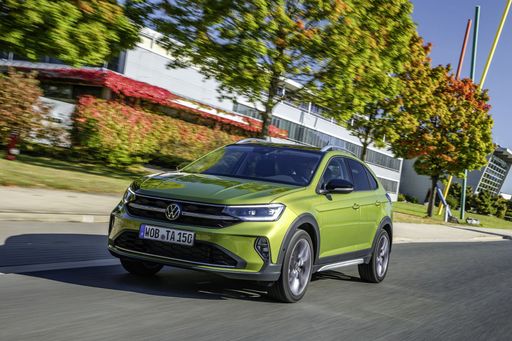 @ Volkswagen AG / VW Media
@ Volkswagen AG / VW Media
VW Taigo
VW T-Roc
The VW T-Roc mixes cheeky, coupe-like styling with the everyday sense and space of an SUV, so it looks fun without sacrificing family sense. It’s a likeable all-rounder with tidy road manners and plenty of personality, ideal if you want a car that’s practical enough for chores but entertaining enough to enjoy.
details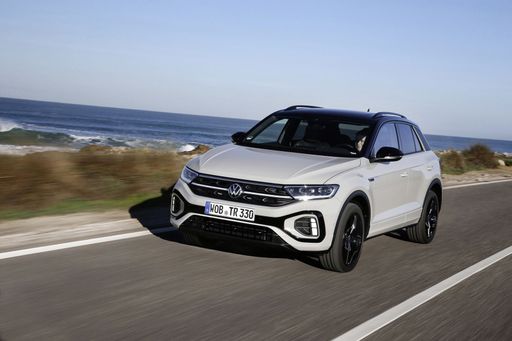 @ Volkswagen AG / VW Media
@ Volkswagen AG / VW Media
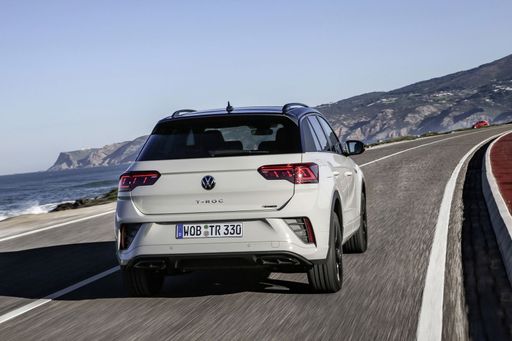 @ Volkswagen AG / VW Media
@ Volkswagen AG / VW Media
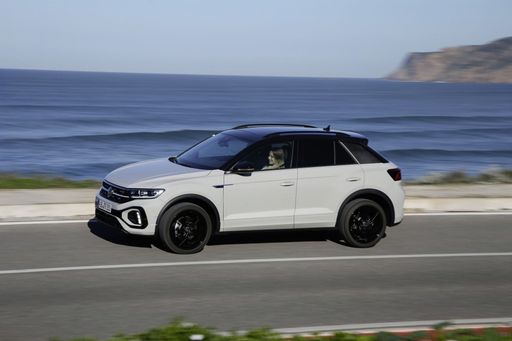 @ Volkswagen AG / VW Media
@ Volkswagen AG / VW Media
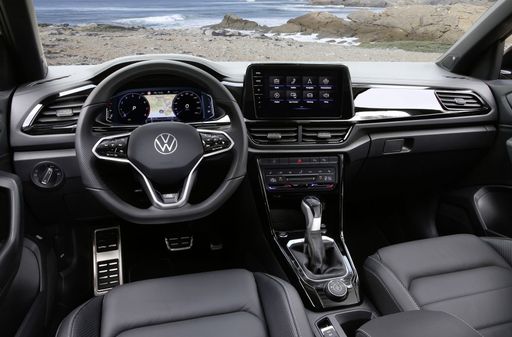 @ Volkswagen AG / VW Media
@ Volkswagen AG / VW Media
VW Taigo
Der VW Taigo besticht durch sein dynamisches Design, das sportliche Eleganz mit robusten Akzenten vereint. Im Innenraum setzt er auf modernste digitale Technologien, die dem Fahrer ein komfortables und vernetztes Fahrerlebnis bieten. Seine erhöhte Sitzposition sorgt für eine hervorragende Sicht und macht ihn sowohl für die Stadt als auch für längere Fahrten bestens geeignet.
details @ Volkswagen AG / VW Media
@ Volkswagen AG / VW Media
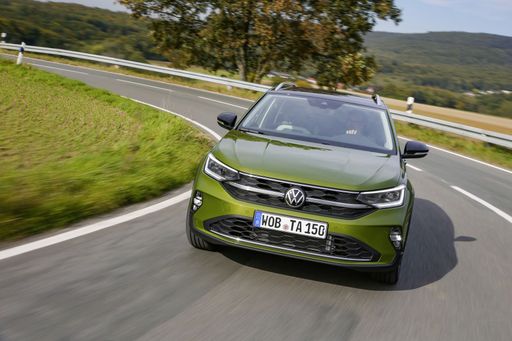 @ Volkswagen AG / VW Media
@ Volkswagen AG / VW Media
 @ Volkswagen AG / VW Media
@ Volkswagen AG / VW Media
 @ Volkswagen AG / VW Media
@ Volkswagen AG / VW Media
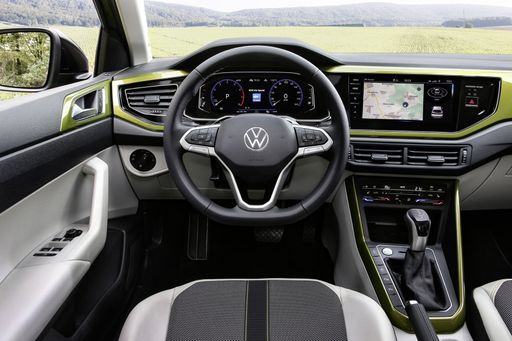 @ Volkswagen AG / VW Media
@ Volkswagen AG / VW Media
 @ Volkswagen AG / VW Media
@ Volkswagen AG / VW Media
|
 @ Volkswagen AG / VW Media
@ Volkswagen AG / VW Media
|
|
|
|
Costs and Consumption |
|
|---|---|
|
Price
26400 - 38000 £
|
Price
19600 - 31300 £
|
|
Consumption L/100km
5.5 - 6.3 L
|
Consumption L/100km
5.3 - 5.8 L
|
|
Consumption kWh/100km
-
|
Consumption kWh/100km
-
|
|
Electric Range
-
|
Electric Range
-
|
|
Battery Capacity
-
|
Battery Capacity
-
|
|
co2
126 - 143 g/km
|
co2
120 - 132 g/km
|
|
Fuel tank capacity
50 L
|
Fuel tank capacity
40 L
|
Dimensions and Body |
|
|---|---|
|
Body Type
SUV
|
Body Type
SUV
|
|
Seats
4 - 5
|
Seats
5
|
|
Doors
2 - 5
|
Doors
5
|
|
Curb weight
1465 - 1539 kg
|
Curb weight
1229 - 1302 kg
|
|
Trunk capacity
284 - 475 L
|
Trunk capacity
440 L
|
|
Length
4271 - 4373 mm
|
Length
4266 mm
|
|
Width
1811 - 1828 mm
|
Width
1757 mm
|
|
Height
1527 - 1573 mm
|
Height
1518 mm
|
|
Max trunk capacity
1350 L
|
Max trunk capacity
1222 L
|
|
Payload
368 - 515 kg
|
Payload
448 - 457 kg
|
Engine and Performance |
|
|---|---|
|
Engine Type
Petrol, Petrol MHEV
|
Engine Type
Petrol
|
|
Transmission
Manuel, Automatic
|
Transmission
Manuel, Automatic
|
|
Transmission Detail
Manual Gearbox, Dual-Clutch Automatic
|
Transmission Detail
Manual Gearbox, Dual-Clutch Automatic
|
|
Drive Type
Front-Wheel Drive
|
Drive Type
Front-Wheel Drive
|
|
Power HP
115 - 150 HP
|
Power HP
95 - 150 HP
|
|
Acceleration 0-100km/h
8.9 - 12.3 s
|
Acceleration 0-100km/h
8.2 - 11.1 s
|
|
Max Speed
187 - 212 km/h
|
Max Speed
184 - 212 km/h
|
|
Torque
200 - 250 Nm
|
Torque
175 - 250 Nm
|
|
Number of Cylinders
3 - 4
|
Number of Cylinders
3 - 4
|
|
Power kW
85 - 110 kW
|
Power kW
70 - 110 kW
|
|
Engine capacity
999 - 1498 cm3
|
Engine capacity
999 - 1498 cm3
|
General |
|
|---|---|
|
Model Year
2024 - 2025
|
Model Year
2024 - 2025
|
|
CO2 Efficiency Class
E, D
|
CO2 Efficiency Class
D
|
|
Brand
VW
|
Brand
VW
|
Is the VW T-Roc offered with different drivetrains?
Available configurations include Front-Wheel Drive.
The prices and data displayed are estimates based on German list prices and may vary by country. This information is not legally binding.
